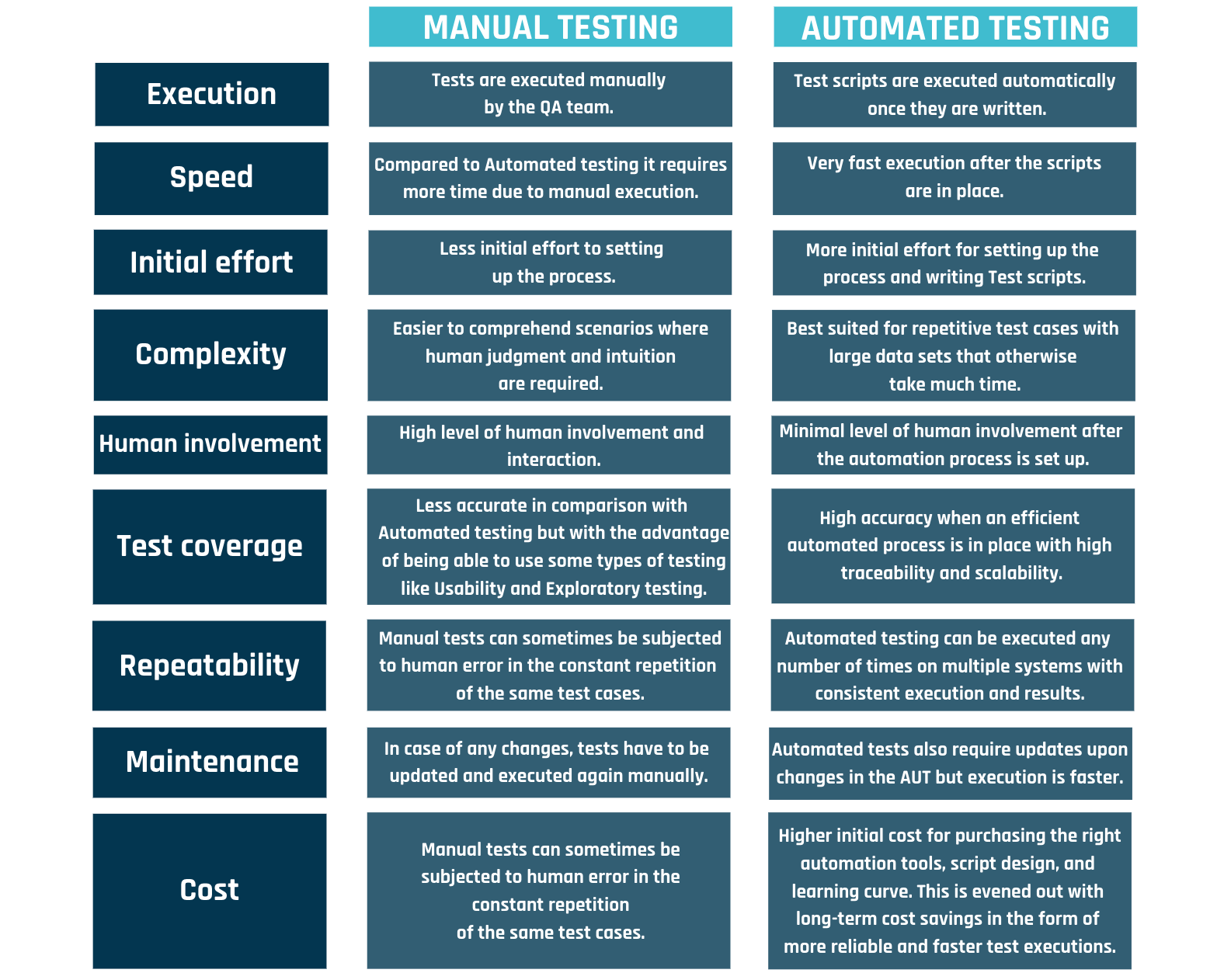Test Automation has become a pretty common buzzword in today’s digital age, and for good reason. In the ever-expanding digital landscape, highways lead to beloved digital products. We’ve all grown accustomed to these products. However, there’s a significant need for individuals who can ensure they function as expected by clients and end-users. These products are precious, and meeting user expectations is crucial.
At Agilno, our primary goal is to guarantee that our clients have stable and high-performing digital products. We provide professional individuals or teams to assist in building your project from the ground up. Our services seamlessly integrate into your workflow, offering comprehensive support for specific tasks or end-to-end development.
QA (Quality Assurance) Engineers are professionals who excel at maintaining app stability and minimizing bugs in digital products. These experts play a vital role at every stage, from the initial idea to the final product release and public judgment. They are crucial in modern Agile SDLC (Software Development Life Cycle). Test Automation has emerged as a crucial tool, enabling faster CI/CD processes with minimal setbacks and maximizing returns on investments.
So, in addition to explaining what Test Automation actually is, let’s list some of the main reasons WHY you should stick around if Test Automation hasn’t fully convinced you it’s the way to go.
Here is a sneak peek of what can be achieved with a robust Automation Process:
- Automated Tests are highly accurate when performing time-consuming and error-prone tasks, ultimately saving you a substantial amount of time.
- Once the automation process is set up, you can expect long-term cost savings through reduced Manual Testing efforts.
- Many tasks that were once handled manually are now automated and activated with a simple click of a button, thanks to test scripts that can run 24/7 if needed.
- Issues are detected much faster and earlier in the development cycle, making them easier to address in the initial stages.
Test Auto…WHAT?!
When discussing Test Automation, it’s essential to first mention Manual Testing and how the two complement each other, filling in each other’s voids.
Manual Testing has been a cornerstone of the IT scene, often preceding automation in the early stages of development. As the name suggests, it involves QA Engineers performing various tests by following pre-written test cases manually. The primary objective is to identify bugs or defects in the Application Under Test (AUT) or System Under Test (SUT). The QA team reports the identified issues back to the development team with a detailed bug report. The report includes information on how to reproduce the identified bugs or defects.
Test Automation, also known as Automation Testing, emerged a little later but quickly gained recognition as an invaluable tool for enhancing the effectiveness, efficiency, and coverage of any QA process. It proves highly valuable when approached with technical and business requirements in mind. Once QA Engineers understand the requirements of your digital product, they identify key components for Automation. They then begin writing automated scripts in their preferred Integrated Development Environment (IDE). These scripts are tailored to provide the appropriate level of complexity and coverage. Various automation tools available in the market, such as Selenium, Cypress, Appium, ACCELQ, TestRigor, Katalon Studio, and more, are utilized for the automation process.
Unfortunately, achieving a 100% fully automated process is incredibly challenging, if not impossible. This is precisely why Manual Testing remains a critical and indispensable part of the QA process. Its significance isn’t going away any time soon. However, if Manual Testing were flawless, there wouldn’t be a need to discuss the reasons for integrating automation into the mix. The best way to understand the synergy between Automation and Manual Testing is by highlighting the main differences between the two.

A keen observer will notice that these two approaches to testing digital products share a common goal of eradicating unwanted issues and bugs, making them strong partners in the IT world, where one complements the other in various ways. Moreover, it becomes evident that solutions from one side can mitigate weaknesses on the other, creating a powerful force against costly and time-consuming mistakes made during the SDLC.
How to implement Test Automation into your SDLC?
Test Automation is undeniably an important and often critical aspect of the SDLC. As the IT industry continues to evolve, our methodologies and approaches must adapt accordingly.
To achieve effective Automation Testing, follow these 5 steps:
- Strategy, planning, and scope of testing
- Automation tool selection
- Test cases and script design and development
- Continuous test execution and reporting
- Ongoing maintenance
By diligently following these steps, you can ensure seamless and successful integration of Test Automation into your SDLC.
Agile development, DevOps-oriented development encapsulated with CI/CD (Continuous Integration/Continuous Deployment) had to adapt to the needs of the public demand to deliver quality products fast, and Automation Testing made that possible by reducing the time-to-market, and providing better accuracy and efficiency when running test suits, among other benefits that it brings to the table.
Automation Testing derives one of its benefits from the maximized use of testing methodologies. Here is a list of the most commonly used methodologies:
Behaviour-Driven Development (BDD): Prioritizes collaboration between developers, testers, and business stakeholders. QA Engineers write test scenarios in a natural language format and focus on the system’s behavior from a user’s perspective.
Test-Driven Development (TDD): Involves creating test cases before writing the code. Automation is integral to TDD, enabling frequent and automated execution of unit tests to validate code functionality.
Continuous Testing: Integrates testing throughout the entire SDLC, leading to one of the key benefits of Automation Testing, known as shift-left testing. This approach emphasizes early testing and validation. If you’re interested in knowing how shift-left testing works in more detail, you can read all about it in a beautifully written blog by my QA colleague available here.
Keyword-Driven Testing: Involves creating Test Automation scripts using keywords that represent specific actions or operations to be performed.
Data-Driven Testing: By separating test data from test scripts, you can test the same functionality with different data sets, thereby increasing test coverage.
Modular Testing: Breaks the System Under Test (SUT) into smaller modular components, with corresponding test cases for each module tested independently.
Hybrid Testing: Utilizes a combination of different testing approaches and leverages their benefits based on the specific needs of the software.
When to use Test Automation?
Mobile and web applications play a significant role in the digital landscape we discussed earlier, catering to large user bases and diverse systems. In such a scenario, Automation Testing becomes crucial. With automated cross-browser and cross-platform testing, you can ensure consistent functionality and user experience across multiple browsers, operating systems, and devices.
Mature and stable applications, having reached a certain level of stability and functionality, greatly benefit from Automated Testing. Minimizing the need for frequent test script modifications results in accurate and efficient automated tests, as there are fewer changing requirements to deal with.
Complex applications with a lot of information and data going in and out need intensive testing efforts. In this type of situation, Manual Testing is not ideal due to the large number of test cases in large apps. However, automation provides test scripts that can run repetitively and efficiently handle the complexity.
Data-oriented applications require the ability to handle substantial and diverse data. With an automated data-driven testing approach, you can validate large datasets accurately and efficiently. This approach is particularly beneficial for applications requiring data validation, such as financial or scientific software, enabling verification and complex calculations.
Applications with API at their core heavily rely on APIs for integrating with external systems or services. Automated API Testing successfully tests these APIs, validating the performance, security, and functionality of API endpoints.
Regression testing is one of the main benefits of Automated Testing since almost all applications introduce changes, fixes, and improvements during SDLC. Automated regression testing will ensure that new updates don’t undermine all the work that was done.
When not to use Test Automation?
Applications in early development stages frequently introduce changes. That version number goes up every so often, Automation Testing is not the right call here especially when validating the initial Proof of Concept (POC).
Applications revolving around UX/UI like social media, online banking systems, weather apps, and countless more use usability testing that focuses on testing user experience and user interface. This kind of testing proved to be quite a challenge for automation testing. Safe to say is better suited for Manual Testing where intuition and decision-making are crucial.
Small-scale applications and one-time testing efforts are also considered a bad idea when it comes to automation. It just doesn’t cut it from the ROI (Return on Investment) point of view where the time consumed to set it all up doesn’t justify the need.
Exploratory and non-functional testing has pretty much the same issue as usability testing. It’s not a surprise since it is a part of non-functional testing. That means it’s also based on human observation, critical thinking, and judgment. Furthermore, adding human intuition and creativity leads to exploratory testing. It stands as one of automation’s significant challenges, continuously reminding us of the importance of Manual Testing.
Cost and resource limitations can hinder the automation testing process, even before considering it as an option. This is a simple equation actually. Without the people who possess the knowledge required to set it up and write the test scripts or the time to do it, you end up with a bigger budget for the development as a consequence. For the time being, there is no really other choice than to abandon the idea.
Legacy applications are often built on outdated technologies. They pose challenges for Automation Testing when it comes to compatibility and complex integration with the legacy systems under test.
Does the cost justify the need for Test Automation?
This has been quite a read, I admit it. But in my defense, I tried to sum up all the little questions you may have to help you answer Why? and When? to use Test automation solutions to best fit your business or digital product. And what kind of QA Engineer would I be if not thorough?
There is that good old saying, “A tool is only as good as the hands that wield it.”. Test Automation can also apply the same principle. In the right hands, it can be a useful tool in your arsenal against bugs and defects. To underline the real reasons WHY you should use Test Automation in the long run. It will save you time and money, increase the accuracy and efficiency of your testing process. The reusability of the test scripts will help speed up the process going forward. Moreover the scalability of your testing efforts will increase significantly as well.
To answer the last question posted here. In short: yes. It does justify the need if you always use automation when it is really necessary. But having in mine, keeping the factors like project requirements, time and resources at hand, budget, and the expected return on investment.
Here at Agilno, we do the hard thinking for you by giving you experts from various fields to work on your digital products and evolving business ideas. If you are ready to build a project with us? Contact us and let’s get started today!



